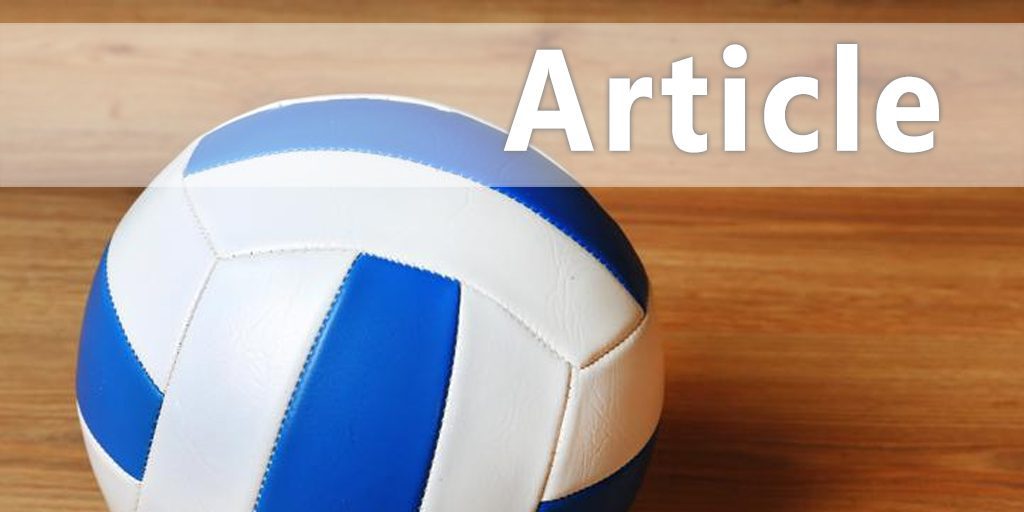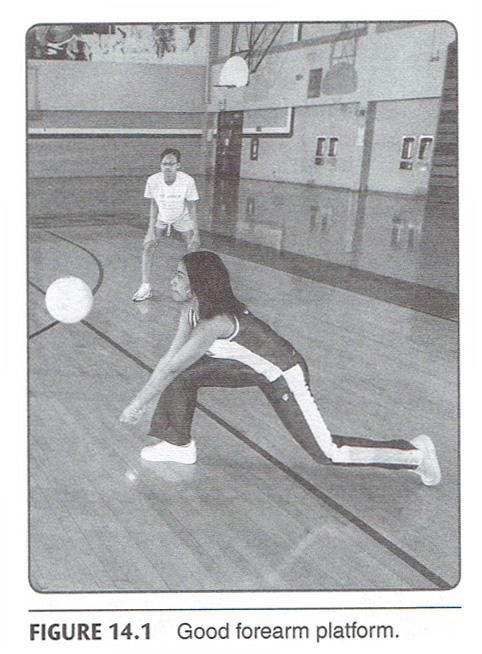| Training Liberos - Passing |
| By: Cecile Reynaud
Originally Published in: The Volleyball Coaching Bible Volume II Provided by: Human Kinetics At the end of the day, controlling the ball is a physics problem. How do we take a ball in space that has some direction and velocity and redirect it to a particular area of the court without catching and throwing it? If you think about it, every skill in volleyball can be addressed in this manner. Once we have figured that out, the next issue is how to repeat the mechanics of this skill over and over at a high level. The best way is to make the mechanics and movement of the skill as simple as possible. We have a tendency to overthink and over complicate things. Players who can create a large, flat platform with the forearms and hold it in space at the right angle can redirect the ball to where they want it to go. Problem solved! Great ball controllers can do this while keeping the platform still, or quiet, relative to the angle they are trying to create to redirect the ball—regardless of how much movement there is in the rest of their bodies. We spend a lot of time in practice trying to calm players' platform movements down. Most of the time, the ball has enough energy to take it where it needs to go. A libero can take away or give some energy in subtle ways, but most of the time, the platform should be fairly still. It should not be swinging in either the vertical or horizontal plane. Above the Waist in Passing Let's start by looking at what is happening above the waist as we analyze the mechanics of passing and playing defense. At the time of contact, the posture should be forward and slumped. The back should be rounded both vertically and horizontally. Imagine sitting comfortably at the dinner table, just before your parents yell at you to sit up straight. This is the correct posture: shoulders forward and relaxed, elbows straight and locked, and hands held together with fingers overlapped and thumbs together in the middle. This is the most common and probably the easiest way to hold the hands when putting the platform together. However, it is not the only way. The shoulders should be shrugged forward and pushed out away from the body. This brings the elbows closer together to create a nice, flat surface. The player can also rotate the thumbs out, thus rotating the radial bones out and exposing the less bony parts of the forearms to create a flatter, softer platform. Once the platform is formed, there should be fairly little movement at the point of contact. There should not be any swinging in the vertical plane while pivoting from the shoulders. The angle of the platform to the torso should remain fairly constant, and any movement to give energy or take it away from the ball should come in a bunting motion, not a swinging motion. The same goes for the horizontal plane: the platform should not swing across the incoming path of the ball. Players who create the proper angle with their shoulders and platform do not have to swing the platform to get the ball to go where they want it to go. This swinging motion is probably the most common mistake we see during passing. It also leads to the most catastrophic errors, typically ending the play or not allowing the team to run its offense. When players swing the platform, they increase the amount of motion and add a timing element to passing mechanics that makes the skill much more difficult to perform consistently. The best analogy is that of a baseball swing: batters who swing hard make contact, but they have a hard time controlling where the ball goes and hit a lot of foul balls. When they want to make sure to control the ball, they bunt. I want our passers to bunt! How players get to this passing position is just as important as the position itself. The movement used to establish this position should be minimal, or as quiet as possible. There is no reason to be flailing all over the place. More movement creates more chance for error and less chance for repeatability. Remember, players have to be able to do this over and over and over. Their movements should be quick, concise, and mechanically efficient. They should begin in a position that closely resembles the final position. (This is described in more detail in the following section, Below the Waist in Passing.) The shoulders should be relaxed and forward, and the arms should also be relaxed and almost straight. It is a mistake to have the elbows bent and tucked up next to the body. The motion to get the platform out should begin by straightening the elbows and reaching the arms out to the proper position and angle to deflect the ball to where it needs to go (see figure 14.1). This is followed by putting the hands together to finish the motion of creating the platform. This should happen with one move, without much motion or swinging of the platform. Again, more motion equals more chance for error.
The head should be still, with the chin up and eyes forward. The player shouldn't look at the ball contacting the platform, but rather, see it in peripheral vision without moving the eyes. It is OK to play the ball in many positions relative to the body. The ball does not have to be between the knees or played at the midline, as long as it is in a plane that is away from the body so the player can create angles with the platform by dropping a shoulder and rotating around their trunk (see figure 14.2).
The ability to create this angle without lifting the platform is instrumental. If the player's platform rises and becomes more parallel with the floor, there is a greater chance for the ball to skip off to the right or left. With the right angle, the ball will deflect to where the player wants it to go. Again, very little movement is necessary when the angle is right. Below the Waist in Passing Now let's look at what is going on with the lower body during passing. Being in a good position of balance helps players create the proper mechanics above the waist. The most ideal position is to have the feet a little wider than shoulder width and the toes pointed slightly in (pigeon toed); the knees and hips should be bent, and the back should be at about a 45-degree angle relative to the floor. One way for players to easily get into this position is to place their hands on their knees and rest their weight on their hands (see figure 14.3). As the ball is being served, they take the pressure off the hands and let the arms relax in front of the body.
This position is very close to the desired final position when contacting the ball. From here, players can accomplish the mechanics of this skill with very little movement. Unfortunately, not all balls are served right to passers. The question then becomes how to move to get into position to pass the ball. When players are moving around the court, they should be able to maintain a balanced position. They should shuffle their feet, moving them in unison to keep a wide base, so that when they do contact the ball, they can quickly be in a good position without a lot of extra movement. Their weight should be slightly forward and on the balls of their feet; keeping the feet slightly pigeon toed helps keep the posture forward and the body balanced. After determining where the serve is going, passers should try to establish a good, balanced base with the feet, legs, and lower body before the ball gets there. Once there, they should use the mechanics described earlier in a concise move with their platform. If they create a proper angle and hold it true at the point of contact, the ball will deflect to its desired position. What if the passer is unable to establish a position of balance relative to the ball? The player can still pass successfully by maintaining the mechanics above the waist. It becomes much more difficult, but good passers can hold the platform still and create good angles in unbalanced positions or when having to move through the ball. The ability to move quickly around the court obviously reduces the occurrence of these situations and helps passers be more constant. However, even the best players in the world have to play some balls from unbalanced positions. A big point of emphasis in training passing is quieting down players' movements. Passers should be quick, concise, and mechanically efficient. Adding movement to the mechanics of the skill (e.g., swinging the platform, bending the elbows, moving the head) increases the chance for error and makes the skill much more difficult to repeat at a high level. |









